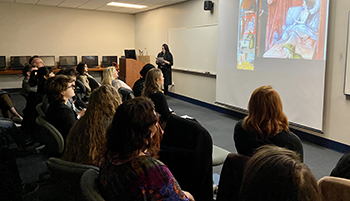Allegory of Masculinity: Bellini's Feast of the Gods
Description/Abstract/Artist Statement
Throughout its long and storied history, Giovanni Bellini’s mysterious Feast of the Gods has inspired interpretations as diverse as the collection of Roman gods pictured therein. It is generally accepted to be an illustration of a fable from Ovid’s Fasti, wherein Priapus attempts to assault the nymph Lotis and is interrupted by the braying of Silenus’ ass. Deeper interpretations vary, from a calendar of the year to quasi-mystical humanist instructions on the best time of year to conceive children. Unusual for a depiction of classical pagan gods, however, it is rarely discussed in the allegorical terms common to Roman mythology and folklore. In fact, there seems to be broad agreement that outside of Bacchus, Priapus, and Lotis, the gods being portrayed are nearly random and have no greater meaning than as characters filling out a crowd scene. A closer look, however, tells a different story. By studying the patron, Alfonso I d’Este, his influential sister the Marchesa of Mantua, Isabella d’Este, and their social circle we can see that the most prominent gods outside of the fable of Priapus - Jupiter, Mercury, Pluto, and Apollo – communicate the distinctly masculine traits and virtues that the patron, Alfonso I d’Este, may have seen in himself and wanted to be remembered as possessing.
Faculty Advisor/Mentor
Anne Muraoka
Presentation Type
Oral Presentation
Disciplines
Ancient, Medieval, Renaissance and Baroque Art and Architecture
Session Title
College of Arts & Letters 1
Location
Learning Commons @ Perry Library Room 1306
Start Date
2-8-2020 9:00 AM
End Date
2-8-2020 10:00 AM
Allegory of Masculinity: Bellini's Feast of the Gods
Learning Commons @ Perry Library Room 1306
Throughout its long and storied history, Giovanni Bellini’s mysterious Feast of the Gods has inspired interpretations as diverse as the collection of Roman gods pictured therein. It is generally accepted to be an illustration of a fable from Ovid’s Fasti, wherein Priapus attempts to assault the nymph Lotis and is interrupted by the braying of Silenus’ ass. Deeper interpretations vary, from a calendar of the year to quasi-mystical humanist instructions on the best time of year to conceive children. Unusual for a depiction of classical pagan gods, however, it is rarely discussed in the allegorical terms common to Roman mythology and folklore. In fact, there seems to be broad agreement that outside of Bacchus, Priapus, and Lotis, the gods being portrayed are nearly random and have no greater meaning than as characters filling out a crowd scene. A closer look, however, tells a different story. By studying the patron, Alfonso I d’Este, his influential sister the Marchesa of Mantua, Isabella d’Este, and their social circle we can see that the most prominent gods outside of the fable of Priapus - Jupiter, Mercury, Pluto, and Apollo – communicate the distinctly masculine traits and virtues that the patron, Alfonso I d’Este, may have seen in himself and wanted to be remembered as possessing.


